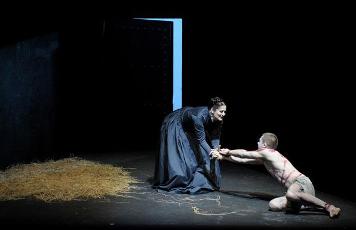Luigi Dallapiccola - Il Prigioniero (2010)
Luigi Dallapiccola - Il Prigioniero (2010)

1. Il Prigioniero (10.III.2010) La madre - Paoletta Marrocu (soprano) Il prigioniero - Lauri Vasar (bass-baritone) Il carceriere/Il grande inquisitor - Donald Kaasch (tenor) Due sacerdoti - Marcel Beekman (tenor) & Nanco de Vries (baritone) Nederlands Concertkoor & Residentie Orkest Adam Fischer – conductor De Nederlandse Opera, Muziektheater Amsterdam 10.III.2010 FM-broadcast Radio 4 (NL) 13.III.2010
Il Prigioniero is one of the enduring masterpieces of twentieth century opera. The similarly inspired choral Canti di prigionia (1938-1941) accompanies Il Prigioniero as Dallapiccola's central and most successful large-scale works. Composed between 1944 and 1948, the composer's libretto is a curious amalgam of Romantic and décadent, fin de siècle oddments informed by the political realities of the Fascist era, to which it is a response. Dallapiccola's extensive account of the genesis of Il Prigioniero begins with his schoolboy discovery of Victor Hugo's poem La rose de l'infante, with its glimpse of the Hapsburg monarch Philip II -- with his centralized authority and support for the Inquisition, he appears as the prototype of such twentieth century dictators as Hitler, Mussolini, and Stalin -- holding the world in a bloody death grip. This claustrophobic prehension suffuses the opera. The action is taken from La Torture par l'espérance, to which Dallapiccola's wife introduced him in June 1939, though the hero of Villiers de l'Isle Adam's brief, Poe-like tale, Rabbi Aser Abarbanel, becomes the nameless prisoner of Dallapiccola's title, representing the political prisoners of all times. The addition of details from Charles de Coster's epic of Flemish resistance to Spanish domination, La légende...d'Ulenspiegel et de Lamme Goedzak (1867), conflates the story with events from the reign of Philip's father, Charles V, namely the warning of the approach of the Spanish fleet by Ghent's great bell, Roelandt, whose motif, representing revolution, is woven through the fabric of the score. Remarkably, the work possesses an integrity and theatrical power transcending its stylistic confluence. In Dallapiccola's distinctive musical idiom, too, several tributaries may be traced. A near-Debussyian sensuousness, for instance, is dodecaphonically articulated in a way owing more to Berg than to Schoenberg -- the diatonic shaping of the tone row representing liberty tellingly contrasting with the predominantly dissonant harmony, to recall Berg's use of a chorale in his Violin Concerto to suggest transfiguration. The impress of Webern's work is also felt in Dallapiccola's exquisitely tense pointillism. The frequent alternation of declamation and angular arioso, for which one might find a precedent in verismo opera or the Verdi of Falstaff, lends the whole an Italianate cast. Finally, a certain mysticism suffuses Il Prigioniero with an eerie radiance. Shifting sensibilities may be measured by comparing Verdi's Don Carlos (1866), which views the same political events from the perspective of kings, princes, and nobles with bittersweet, often pungent, Romanticism, and Dallapiccola's modern parable of anonymous horror forecasting the "detainees" and "disappeared" of the world. --- Adrian Corleonis, Rovi
download: uploaded yandex 4shared mediafire solidfiles mega zalivalka filecloudio anonfiles oboom








